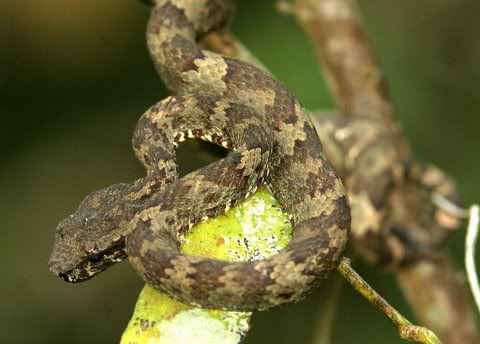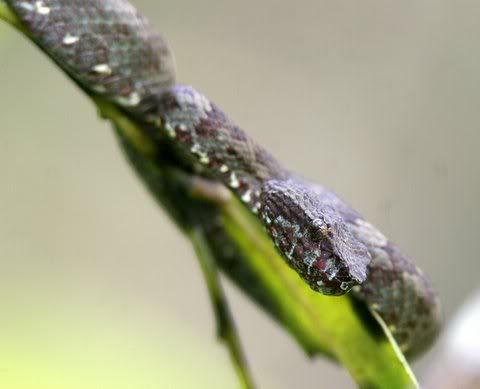Snakes and Frogs of Agumbe
October 10, 2008
Sssssnakes…they don’t always hiss and look dramatic; they just are THERE as you pass by, and you do a double take, knowing that you are looking at a deadly specimen.
This MALABAR PIT VIPER was on a bush very close to the ARRS main building:
This is as much of a close-up as I dared to take!
 The belly is so distended with food, we couldn't believe it.
I took another snap with the flash, as the light was so poor:
The belly is so distended with food, we couldn't believe it.
I took another snap with the flash, as the light was so poor:
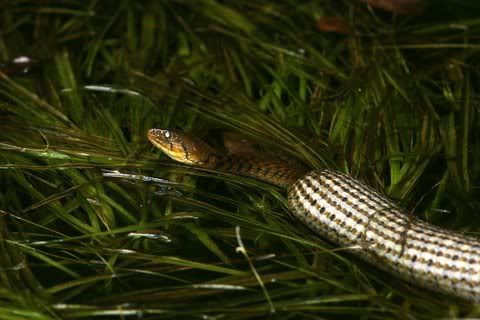 This CAT SNAKE was also a real beauty, and coiled up artistically to give us a good opportunity to shoot:
This CAT SNAKE was also a real beauty, and coiled up artistically to give us a good opportunity to shoot:
 We had two separate sightings of the harmless VINE SNAKE; one on the first day and one on the second.
Can you see it in the bushes?
We had two separate sightings of the harmless VINE SNAKE; one on the first day and one on the second.
Can you see it in the bushes?
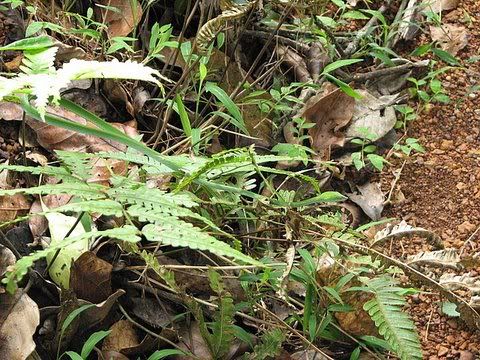 Here it is, closer to the camera:
Here it is, closer to the camera:
 KM is in the background, taking pictures, while the vine snake looks for all the world as if it's laughing:
KM is in the background, taking pictures, while the vine snake looks for all the world as if it's laughing:
 It's not, it just shot out of the bushes and was actually trying to get out of the lenses' range, the shy creature!
While we were seeing these beauties, we also found a lot of their prey as well; so let me show you some of the frogs!
The most lovely frog was the GOLDEN FROG (Silvirana aurantica):
It's not, it just shot out of the bushes and was actually trying to get out of the lenses' range, the shy creature!
While we were seeing these beauties, we also found a lot of their prey as well; so let me show you some of the frogs!
The most lovely frog was the GOLDEN FROG (Silvirana aurantica):
 This one was earlier called the PADDY FIELD FROG, Mittal informs me; now, their classification has changed, and I must, apparently, only say that it belongs to the Fejarvarya species:
This one was earlier called the PADDY FIELD FROG, Mittal informs me; now, their classification has changed, and I must, apparently, only say that it belongs to the Fejarvarya species:
 This beautiful PSEUDO HOURGLASS FROG is aptly named, if you look carefully at the "broken hourglass" pattern on its back!
This beautiful PSEUDO HOURGLASS FROG is aptly named, if you look carefully at the "broken hourglass" pattern on its back!
 This one is as yet un id'd...I can call it (quite defiantly--apparently the old "Rana" and "Bufo" classifications for frog and toad are gone now!) Rana agumbensis!
This one is as yet un id'd...I can call it (quite defiantly--apparently the old "Rana" and "Bufo" classifications for frog and toad are gone now!) Rana agumbensis!
 This one is also well named; it's a BUSH FROG (Philautus sp):
This one is also well named; it's a BUSH FROG (Philautus sp):
 Apparently, this is the only frog where there is no tadpole stage but the adult hatches directly from the spawn. I never knew that there was such a frog!
Another descriptive name is the SKITTERING FROG (Euphlyctis cyanophlyctis), that is an acquatic frog, and just does that--skitter--across the water:
Apparently, this is the only frog where there is no tadpole stage but the adult hatches directly from the spawn. I never knew that there was such a frog!
Another descriptive name is the SKITTERING FROG (Euphlyctis cyanophlyctis), that is an acquatic frog, and just does that--skitter--across the water:
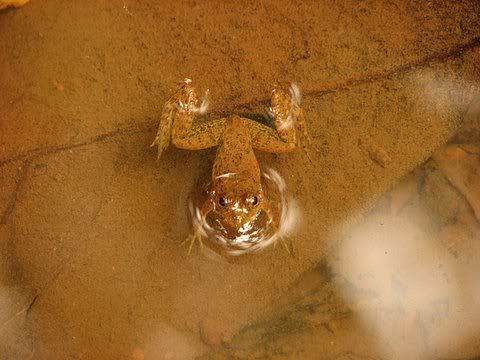 And in a total failure of the imagination, this one's called a BICOLORED FROG (Clinotarsus curtipes)!
And in a total failure of the imagination, this one's called a BICOLORED FROG (Clinotarsus curtipes)!
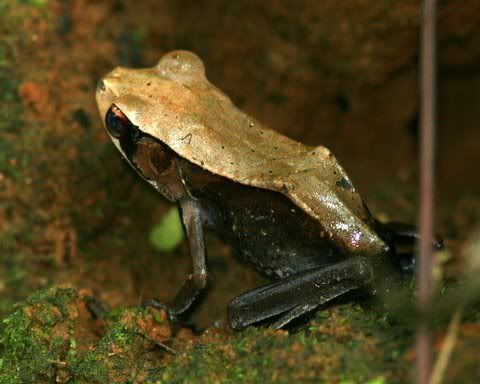
The same strange matter-of-factness has named this frog the INDIAN BULL FROG (Hoplobatrachus tigerinus):
I want to know why, when animals and birds get “red-eye”, frogs get violet and orange eyes with the flash?
Eat, or be eaten…the insect is eaten by the frog, the frog is eaten by the snake, which is eaten by the birds of prey, and so the food chain goes!

